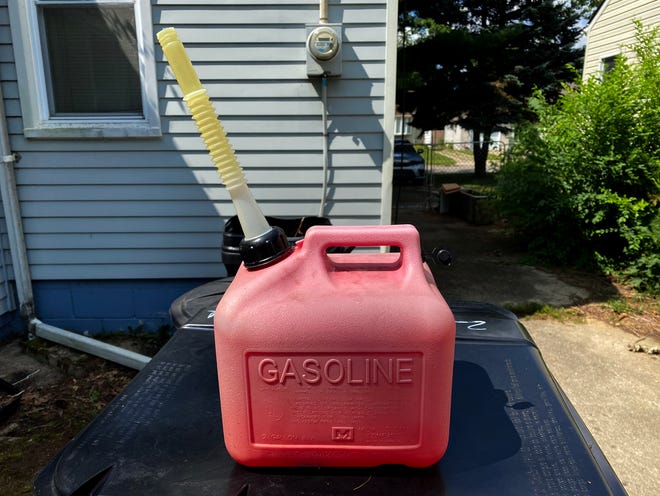5 Gallon Gas Can With Easy Spout
My friend Greg Lewis used to say in high school: "He's so dumb, he couldn't pour pee out of a boot if the instructions were written on the heel."
Courtesy of a recent five-day DTE power outage, I think I know what that apocryphal numbskull does for a living: He designs gasoline cans.
During the blackout, I spilled gasoline on myself and a running generator — neither's a good idea, kids — wasted time and money shopping, and cursed a blue streak, all because some industrial designers apparently never saw anybody pour a cup of coffee.
Seriously. How do you screw up letting gravity move a fluid from a high place to a lower one?

More important, how do you pick a can that won't turn you into a walking wick? And how did a simple tool like a gas can morph into a Rube Goldberg machine requiring three arms and double-jointed thumbs?
Bonus: Did you know there's a black market for easy-pour spouts? I can hook you up.
More: California Air Resources Board gas-can regulations
More: National Wildlife Coordinating Group standards for transporting fuel
More: Gas Cans that Actually Work
A good idea. Bad solutions
Here's my story:
I've had a 2-gallon plastic gas can for years. It's all I need to refuel my lawn mower and snow blower, but it was insufficient when I had to fill my generator's 7.5-gallon tank a couple of times a day to keep my house cool on 90-degree days and preserve frozen food for myself and my neighbors.
I needed 1-2 more cans. That's when the frustration began.
In the early 2000s, first the California Air Resources Board (CARB) and later the U.S. Environmental Protection Agency banned a couple of longtime gas can features: permanently open nozzles and relief valves.

In simple terms, this means that all new gas cans have some kind of trigger you activate to pour gas, and they lack the valves that promoted smooth flow by letting air in as the can emptied. Among other good things, the regulations also require plastic cans be impermeable, so gasoline doesn't evaporate through them into your storage space.
There are good reasons for the rules: They reduce spills and evaporative emissions, significant sources of emissions that contribute to climate change and other issues.
Unfortunately, those good regulations opened the door for some truly awful product design. Designs I didn't recognize till I wasted $40 on a couple of nearly unusable cans.
A button in the top of one can's spout had to be pushed simultaneously forward and down to pour, a difficult motion exacerbated by overly stiff springs. Without three arms, it was nearly impossible to hold the can in place while also opening the spout. I repeatedly spilled large amounts of gasoline on myself and the top of my Generac generator as I tried to hold the can in place with my body or an elbow. The spring breaks in over time, but with the awkward design, it gets easier, but it never gets easy, to borrow singer Jason Isbell's life lesson.
A ridge midway down the other's spout is designed to catch on the tank's lip, and open the spout. Not a bad idea, but to engage it, you have to hold the spout at a 45-degree angle or sharper, steep enough to ensure an initial rush of gasoline that makes spilling likely, the very problem regulators aimed to eliminate.
The answer
It's a truism in the auto industry that good design doesn't cost more than bad design; it just requires more thought. My search for cans less likely to immolate me and poison the environment bore that out.

I eventually found a 2.5-gallon can with an easy to use trigger that allows you to regulate flow so an initial rush of gasoline doesn't overwhelm the inlet.
The brand is Easy Can. I paid about $20 for one at Home Depot.
My generator has a 7.5-gallon tank, so I needed another can. Sadder but wiser after my bad purchases, I knew the product characteristics I needed when I went to Amazon looking for a 5-gallon can.

I found a No Spill can with the same trigger design — perpendicular to the spout; put a finger on either side and you can pull while holding the spout steady.
Best of all, the No Spill has handles on top and its rear, making it easy to hold steady while tipping the can to pour. A 5-gallon plastic can of gasoline can weigh about 35 pounds, so a single handle on the same top surface as the spout isn't helpful. I paid $33.99 for the big No Spill.
While shopping on Amazon, I also saw kits for replacement spouts that are open, like pre-regulation cans. The kits included tools to install a vent in a new plastic can.

The no-spill regulations are good environmental policy so I can't endorse the throwback aftermarket kits over the effective designs of the Easy Can and No Spill I bought.
After spilling gas on myself and a hot generator using a couple of poorly designed cans, though, I wouldn't hesitate to replace either of them with a retro-spout.
shieldswitace1970.blogspot.com
Source: https://www.freep.com/story/money/cars/mark-phelan/2021/08/21/how-not-set-yourself-fire-during-blackout-gas-cans-101/8201633002/
0 Response to "5 Gallon Gas Can With Easy Spout"
Post a Comment